Fabric manufacturers and upholsterers balance traveler and commuter requirements.
 Whether for business or for pleasure, people are always on the go. More than 121 million U.S. workers are employed full time, according to 2015 statistics from the U.S. Department of Labor. To reach their work destinations, 85 percent of these workers commute in automobiles, and another 5 percent take public transportation, according to the U.S. Census Bureau. As for the tourism industry, 2.2 billion domestic trips were reported by the U.S. Travel Association in 2015.
Whether for business or for pleasure, people are always on the go. More than 121 million U.S. workers are employed full time, according to 2015 statistics from the U.S. Department of Labor. To reach their work destinations, 85 percent of these workers commute in automobiles, and another 5 percent take public transportation, according to the U.S. Census Bureau. As for the tourism industry, 2.2 billion domestic trips were reported by the U.S. Travel Association in 2015.
These commuters and travelers may take for granted the interior comforts and conveniences of their automobiles, trains, busses and planes. However, experts in the industrial fabrics industry juggle numerous concerns—like safety regulations, design trends and durability expectations—to ensure the well-being of drivers and passengers.
Safety first
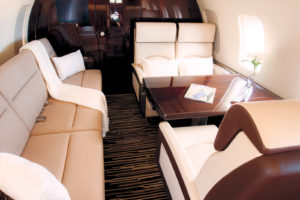
“The biggest safety standards that affect fabric choices are the strict fire-retardance regulations,” says Jason Estes, director of sales for Armonk, N.Y.-based Tapis Corp., which supplies fabrics globally for commercial air carriers as well as for VIP and business aviation.
“The issue is not only the material that is selected, but also how it will burn with other layers that it will be built with to complete a part,” Estes explains. “For instance, most vertical-surface applications on a commercial aircraft require materials to meet heat release and smoke density. The testing for these requirements is done in combination with the glue, composites and foams.
“We have in-house testing capabilities to accelerate testing and R&D,” he adds. “We also have an on-staff chemist who has been used as a resource for challenges our customers have faced.” Those customers include powerhouses like Emirates, Lufthansa, British Airways, Virgin and Qantas.
“Our fabrics can be treated to meet any FAA [Federal Aviation Administration] requirements, and vertical-surface applications must pass even stricter testing,” Estes says. “We recently developed a custom Ultraleather® specification that is manufactured with low-heat-releasing, fire-retardant resins.”
“In order for fabrics to be used in an aircraft, a sample must pass all of the flammability requirements established by the organizations governing aviation,” says Ron Larabie, president of Dallas, Texas-based JetSet Interiors. “There are slight differences between the Federal Aviation Administration and the European Aviation Safety Agency (EASA)[the European equivalent of the FAA], but the types of fabric we use are approved by both. Since receiving our EASA certification, we’ve made several successful European deliveries and continue to receive orders from overseas.”
JetSet, which has more than 50 employees in Texas, California and Connecticut, recently moved its headquarters into a 24,000-square-foot facility, expanding its portfolio of services to include cabinet making. In February, JetSet opened a 15,000-square-foot branch to add commercial-market capabilities.
“We were approached by several aviation firms that were looking to fill large orders for commercial carriers,” Larabie says. “With automatic-cutting capabilities and a 24-hour assembly line, we succeeded in elevating our production capacity, which now exceeds 1,800 pieces a week.”
Roadworthy
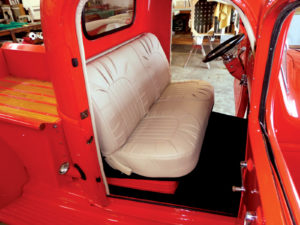
Suppliers and servicers of fabrics for automobiles don’t have to comply with guidelines as strict as those for aircraft or worry as much about weight, but they still have to meet exacting requirements, including Federal Motor Vehicle Safety Standards.
“All of our fabrics conform to federal and customer standards for durability and safety,” says Sidney Locke, director of strategic marketing and communication for Sage Automotive Interiors. He adds that testing for the Greenville, S.C.-based company is conducted in certified labs.
Sage has been in business for 70 years and maintains a workforce of nearly 2,000 in four South Carolina plants and sales/design and manufacturing locations that stretch across the world from Brazil to Korea.
“Working across the globe can be very interesting. We may be working with a design team in Asia interested in a particular European fashion trend for a vehicle interior that will be sold mostly in North America. Automotive textiles is truly a global business,” Locke says. “We collaborate very closely with design teams at automotive OEMs to design interior fabrics that fit the taste of the consumer.”
Sage supplies fabric that is almost 100 percent polyester. Its luxury Dinamica® is a recycled polyester-based nonwoven suede. The company’s technology—used in its waterproof FXC® for SUV enthusiasts and stain-and-odor-resistant, antimicrobial YES Essentials®—adds a “functionality that can be applied to any fabric,” Locke says.
Durability matters
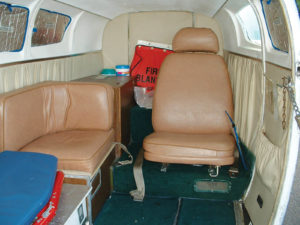
Bergen Upholstery Inc. of Teterboro, N.J., has been serving the transportation market since the 1940s. These days, 65 percent of its business involves refurbishing interiors for private motor coach and bus companies. The rest involves public transit—mostly buses, but also trains.
“They spec fabrics when they’re building new buses, so when they refurbish them, we use the same materials,” Bergen president Nancy Citti says. “We have to match what’s on the ceiling and sidewalls. Sometimes we have to dismiss a lot of fabrics, because they don’t want to rip everything out. It limits the fabrics I can show them.”
According to Citti, vinyl has a long history of use for public transit seats. Unfortunately, riders found the seats hot, and operators found them prone to graffiti. The public transportation market consequently switched to wool. Then a few years ago, rampant reports of bed-bug infestations led some transit authorities back to vinyl.
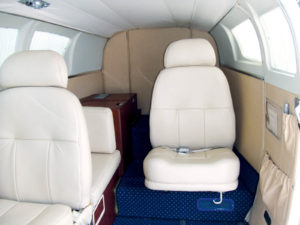 Citti cites Camira, formerly Holdsworth Fabrics, headquartered in West Yorkshire, U.K., as the prime source of textiles for the public transit market.
Citti cites Camira, formerly Holdsworth Fabrics, headquartered in West Yorkshire, U.K., as the prime source of textiles for the public transit market.
“It has a great track record,” she says. “It lasts forever—sometimes longer than the buses themselves.”
A big seller among Bergen’s private motor coach customers has been polyester from Fairfield, N.J.-based De Leo Textiles, which is less expensive than wool.
“Private coach owners are very cost driven, and polyester provides interiors a beautiful look at a low cost,” Citti says.
“Fabric manufacturers often include many designs that are not readily selected and then are discontinued,” she adds. “That creates a problem when you’re refurbishing seats eight years down the road.”
Mixing it up
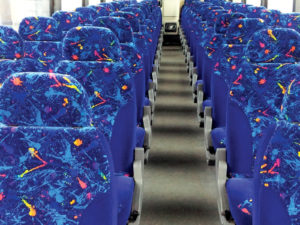
Chicago-based Freedman Seating Co. uses vinyl, polyester, wool and blends in all its transportation markets and leather in the executive limousine and rail markets.
“Public transportation leans toward vinyl because it is easier to clean,” says John-Paul Paonessa, marketing manager. “Private motor coach companies typically use a plush cloth with vinyl headrests and side bolsters, again for easy-clean areas.”
Freedman’s antibacterial, antimicrobial Repel line, made with 50 percent recycled polyester, can be used in any market, but is especially useful for dial-a-ride and other public transit vehicles, Paonessa notes. And CMI Nanocide™ embeds nanoscale silver particles into vinyl to make it antimicrobial.
A recent addition to the Freedman portfolio is Camira polyester treated with Defender technology, which adds antibacterial, antifungal and antistain properties to the fabric. Another addition is Priority Vinyl, which is stain-resistant, antimicrobial and antibacterial, for designated seating for people with limited mobility.
“More public transit agencies are looking for ways to secure seats for ‘priority’ passengers,” Paonessa says. “Making these areas stand out promotes a positive awareness that these seats and sections are reserved.”
Another recent addition is the Eleganza Collection, which Freedman promotes to the limousine and executive shuttle markets.
“Many customers are looking for a more luxurious seating option, with comfort and style at the forefront,” Paonessa says.
All of the company’s fabrics meet Federal Motor Vehicle Safety Standard 302, and its D-90 vinyl meets an additional standard of the Federal Transit Administration for low-smoke, low-flame materials.
Regulation bound
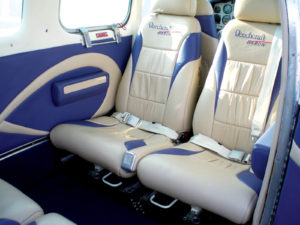
Chip Lueck opened The Recovery Room, an auto trim shop in Panama City, Fla., in 1978 and branched out into canvas awnings and boat covers, tops and interiors six years later. These days, Lueck also offers airplane upholstery services.
In automotive applications, the company primarily uses materials that match what originally came with the car. For aircraft, Recovery Room has replaced original vinyl and cloth seats with Ultraleather and embroidered aircraft numbers and logos into airplane seating.
“On the aviation side, I do not use anything other than FAA-approved fabrics,” Lueck says.
“Ultraleather has taken the market by storm,” he adds. “It’s lighter than leather, comfortable and looks good. It’s easy to work with, and it’s cost effective because there’s less waste than with cutting leather.”
Jason Estes of Tapis Corp. says he is also a fan of Ultraleather, especially because his employer promotes its commitment to providing the aircraft interiors industry with products that are safe for the environment.
“As a result of its substantially lighter weight, Ultraleather reduces fuel consumption, driving costs down and reducing the carbon footprint,” he says.
Other Tapis products for the market include its stain-resistant Ultrasuede®, made of recycled ultra-microfibers, and TapiSuede®, composed of 88 percent recycled polyester and 12 percent polyurethane. Both are suitable for seating and pillows; vertical surfaces such as sidewalls; headliners; and liners for closets, baggage compartments and drawers.
Tapis’s Grospoint and Geneve, which are made of 100 percent wool with a fire-retardant backing, are used for sidewalls; bulkheads; and liners for closets, baggage compartments and drawers.
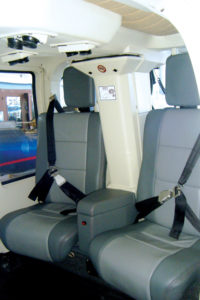
Air Interiors.
In 2006, after nine years offering land- and marine-based fabric solutions, Terri Madden, owner of Sand Sea and Air Interiors, broadened her San Juan, Puerto Rico-based company’s repertoire to include aircraft interiors and became an FAA Certified Repair Station. The regulated aspect of her business has had an effect beyond purely monetary.
“There are policies, procedures and inspections for every item from start to finish that must be recorded. It has helped us be more organized on all our projects,” she says, noting that her staff of three, as well as the contractors she uses, work interchangeably on residential and commercial projects as well as marine and aircraft jobs. “Aviation is still a small segment of our operations,” she admits. Thus far, projects have ranged from six-passenger aircraft used to ferry passengers “down island” to a private jet that provides charter service.
“This past year, we have been busy replacing seat covers for a 30-passenger Saab aircraft that flies tourists throughout nearby islands,” Madden says. “We replace the removable covers 10 at a time in order for the aircraft to continue flying. We also have done new seating and carpet for four- to six-passenger helicopters used for business operations, such as the electric company, for quick transportation around the island.”
Madden uses vinyl for some seating and wall panels, and leather and Ultraleather for more luxurious seating.
“Material choices are generally guided by the aircraft make, model and age,” she says. “Everything has to meet Federal Aviation regulations for flammability. We provide all material specifications in a customer work-order package that must be maintained for a minimum of two years.”
Moving forward
“Light earth, cream and off-white have been the preferred color in VIP aircraft for the past two decades, with leather being the material of choice,” Larabie says. “In the last few years, we have seen a resurgence of brighter colors, such as red and blue, with customers also opting for less-common materials that may even be considered exotic, for example, ostrich hide. And visible carbon fiber gives a very high-end look.
“As materials and processes are developed to the point where they can meet strict aviation standards, they change the industry,” Larabie notes. “If smart fabrics develop to the point where they can survive the rigorous testing that the aviation industry requires, it may very well become the next preferred material.”
Custom Appreciation
There is little customization in public transit, but occasionally Bergen Upholstery Inc. gets a request for logos on seat covers. Nancy Citti, president for Bergen, reports that the company has been supplying new seat pads with a priority-seating symbol on a weekly basis under a 140-bus contract.
Most of Freedman Seating Co.’s customization work relates to embroidered logos in motor coaches and executive limousine shuttles.
“On occasion, we will work with our upholstery vendors for materials with logos woven into the fabric,” says John-Paul Paonessa, marketing manager at Freedman. “Our custom sewing packages might include double-stitching or unique patterns within a seat cover.”
“Our customers are always looking for something new and different from what they have been seeing for the past few decades,” JetSet Interiors president Ron Larabie says. “The need to accommodate new portable technology has had a huge impact on the type of customization that we perform. We do a lot of modifications for plug-ins and pockets, especially in older aircraft.
“Customers want the convenience of charging devices from the comfort of their seats. Some of the more unique modifications include digital tablet holders that are pliable and directly attached to the seat. These modifications require research and development to conform to regulations. But customers are usually more than willing to pay a premium for the added convenience. There is also the constant striving for better comfort that helps drive the development of custom interiors.”
“Customization has been a market demand for some time,” says Tapis Corp. director of sales Jason Estes. “We have custom-engineered products for airlines and OEMs to meet specific requirements, including colors, finishes and technical specifications such as gloss level, weight, breathability, thickness and enhanced properties such as ink and stain protection for seating.”
Tapis offers a custom laser-etching process that can duplicate a pattern from a photograph to create exclusive decorating effects and has worked with Kalogridis International of Dallas using Deconel® panels to develop 3-D designs for the commercial and VIP aircraft markets.
“We have also created 3-D textures on our Ultraleather® products,” Estes says. “We have seen a strong interest from designers for them.”
Ultraleather® vs. leather
Ultraleather® has become a go-to fabric choice for aircraft interiors, according to The Recovery Room owner Chip Lueck.
Leather hides are of irregular thickness, and American leather has branding and barbed-wire marks, Lueck explains, adding that roll goods don’t have those problems.
“A leather hide is generally equivalent to three yards of fabric,” says Terri Madden, owner of Sand Sea and Air Interiors. “Leather can be purchased as either half or full hides. One must carefully calculate the quantity needed when estimating and purchasing leather. With the cost average of $750 for one hide, it is significantly higher than three yards of Ultrasuede® or other leatherettes that range close to $80 a yard.
“Technology offers a wide range of synthetic materials in 54-inch widths versus the irregular shape of a leather hide,” she continues. “Leather is generally our clients’ choice of materials. It is luxurious to work with and durable and, with proper care, its character is enhanced with age.”
 TEXTILES.ORG
TEXTILES.ORG


